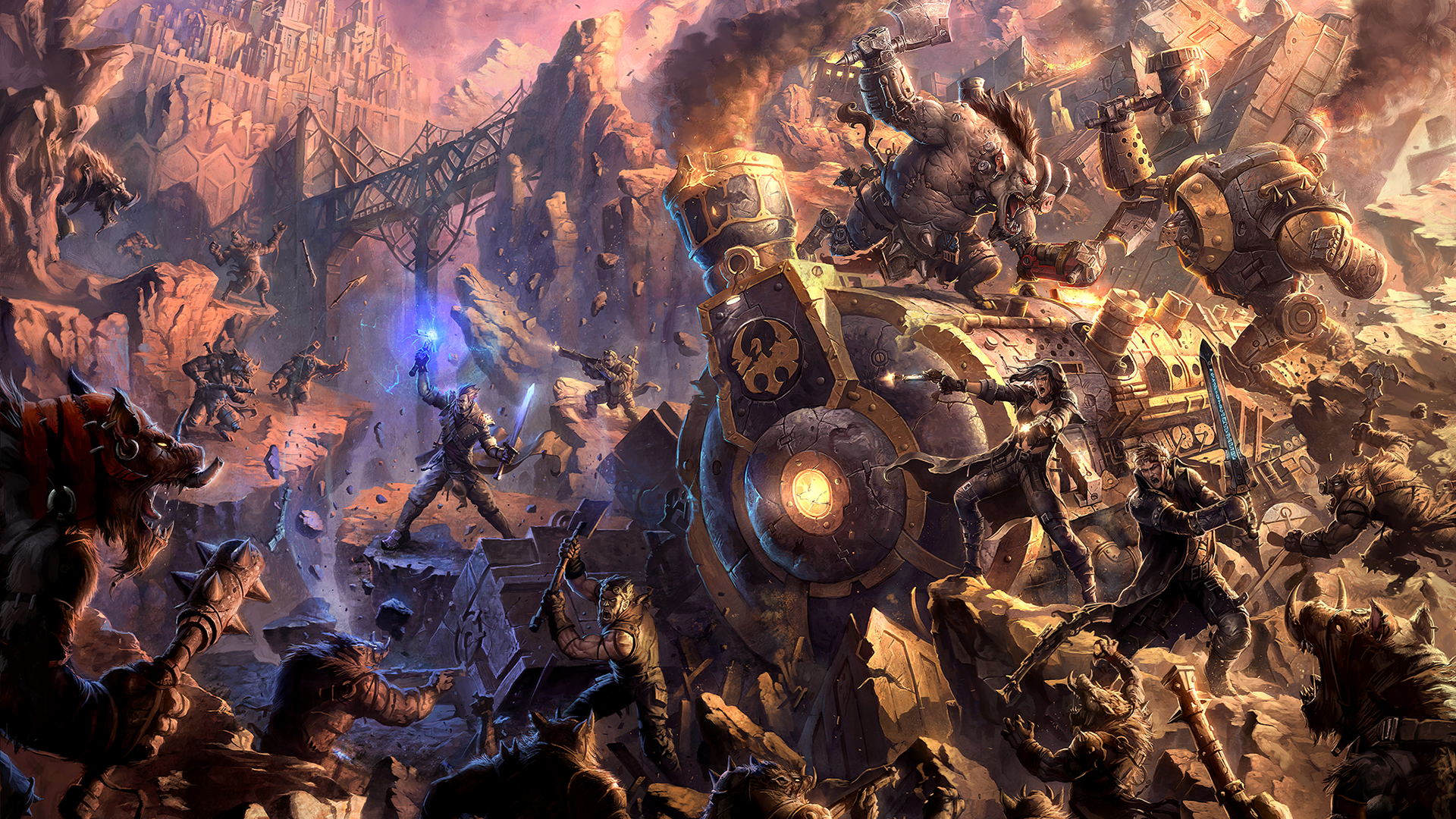
The Iron Kingdoms Era
Era beginning/end
Saying that the years following the defeat of the Orgoth were relatively peaceful simply emphasizes how war-torn the history of western Immoren truly is. The signing of the Corvis Treaties established borders that would hold for centuries and ushered in an era of reconstruction, but numerous conflicts were on the horizon.
New arcane orders were established to study the nature of
magic and the secrets of alchemy (see Alchemist), and great advances were
made in Mechankia technology—including the invention of
the first Steamjacks, smaller and more versatile versions of
the massive colossals. At the same time, Cygnar was beset by
Trollkin uprisings in the Thornwood and the Gnarls, while
the newly formed nation of Khador accumulated power with
an eye toward conquest.
In 482 AR, a charismatic Menite priest named Sulon began
calling for pilgrims to come to the eastern part of Caspia.
By this time, worship of Morrow had become the dominant
faith in the region, and Menites had begun to see themselves
as a persecuted minority. As Cygnaran Menites gathered
in the thousands to hear his words, Sulon declared himself
hierarch, a title associated with the ancient priest-kings of
the Lawgiver. The result was the beginning of the First
Cygnaran Civil War, a conflict that would split the young
nation in two.
The fighting raged for two years, devastated the Cygnaran
capital Caspia, and claimed the life of Hierarch Sulon.
Ultimately, a Morrowan priest named Shevann—who later
ascended to join Morrow upon her death—brokered a
tenuous peace. These negotiations led to the creation of the
Protectorate of Menoth. Caspia was split in two, as Cygnar
ceded the portion of the city that lay on the eastern banks
of the Black River. The Menites renamed the city Sul in
honor of their fallen hierarch, and it became the first capital
of the new Protectorate, which covered the lands to the east
between the Bloodstone Marches and the Meredius.
The harsh and inhospitable nature of these lands was
seen by the Menites as a challenge from their creator, and as
they brought the native populations to heel and discovered
numerous previously unknown natural resources within
the forbidding landscape, they came to perceive the hand of
divine providence in their lot. Among these resources were
plentiful diamonds that could be traded to foreign nations,
as well as underground deposits of flammable oil, which
the faithful refined into the incendiary weapon known as
Menoth’s Fury. Although the conditions of the accord that
had ended the civil war prohibited the Protectorate from
assembling a standing army, the Menites were building a
secret force and outfitting it with all the tools and weapons at
their disposal.
Internal division was not the only threat to Cygnar
during this time. In 520 AR, King Vygor of Khador sent
a diversionary force against the borders of Llael, forcing
Cygnar to commit military resources to defend its ally. At
the same time, Vygor sent a much larger force of soldiers and
warjacks (Steamjacks) through the Thornwood toward largely undefended
Cygnaran territory, chopping a miles-wide path ultimately
called the “Warjack Road.”
So began the First Thornwood War, which was only
the earliest of many expansionist maneuvers by Khador,
culminating in its invasion and occupation of Llael in 604 and
605 AR. Khador would hold much of Llael for years despite
the combined efforts of the Llaelese Resistance, Cygnar , and
the Protectorate of Menoth. Not until the Claiming did Llael finally
throw off the Khadoran occupation entirely, and even
today, the former Llaelese city of Laedry sits entirely within
Khador’s borders.
Prince Vinter Raelthorne IV of Cygnar was a hero of
the First Thornwood War, and when his father perished
with suspicious suddenness in 576 AR, he ascended to the
throne. This event marked the beginning of a dark age for
the nation, as the paranoid and tyrannical Vinter Raelthorne
implemented the Cygnaran Inquisition.
The Inquisition was ostensibly tasked with rooting out suspected witches, but
its actual function was to persecute or otherwise eliminate
any dissidents or perceived threats to the king’s rule. Vinter
IV’s Inquisitors often struck even those who were innocent
of these transgressions, sowing a sense of fear that cast a
pall over the kingdom. These unpopular actions eventually
drove Vinter IV’s younger brother, Prince Leto, to stage
what became known as the Lion’s Coup in 594 AR. With
the aid of the Church of Morrow, Leto ousted his tyrannical
brother and established himself as monarch. Before Vinter IV
could be captured, he escaped in an experimental airship and
disappeared over the Bloodstone Marches.
Leto proved to be a capable and popular ruler, and he
ushered in what many see as a golden age in the history of
Cygnar. His elder brother was not gone for good, however.
In 603 AR, Vinter IV returned to take Corvis at the head
of an army of monsters and unfamiliar beings known as
skorne, who hailed from across the Stormlands. The invasion
probably would have succeeded if not for the intercession
of Alexia Ciannor, a young sorceress whose mother was
unjustly executed as a witch. Alexia had become the guardian
of a powerful artifact known as the Witchfire, and she used
this dread blade to summon the exalted dead of the Legion
of Lost Souls, who repelled Vinter IV and his allies on the
Longest Night. Alexia and the Legion would later play a
pivotal role in the Battle of Henge Hold during the Claiming.
